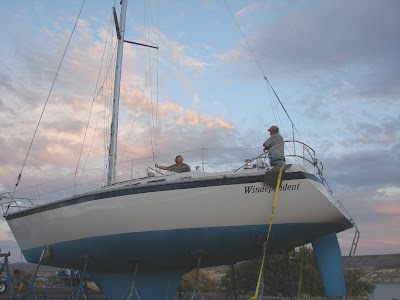7b Launching a sailboat with a large trailer extension; at the top of the ramp
Small sailboats are simple to launch from a beach or ramp. A simple launching dolly may be all they need, or even just a husky crew to lift a Sunfish off the top of a car or truck and carry it to the water.
Daysailers and sailboats with daggerboards or swinging centerboards are also easy to launch; the trailer is simply backed down into the water until the boat floats and is ready to go.
But, sailboats with fixed keels are entirely another matter to launch.
A few keelboats have relatively shallow keels and will float in as little as three feet of water. For these, a trailer extension may suffice to get the boat deep enough in the water for launch. To launch one of these rigs, a sailor chocks the trailer wheels, pulls out a pin in the forward portion of the trailer frame work, and draws out an extension tube or bar that may add several to as many as twenty feet to the length of the trailer. The bar is pinned in the extended position, the wheel chocks are removed, and the boat can be launched.
Many small and medium-sized keelboats draw four to six feet of water and a typical trailer extension won't work. These boats use launch ropes or cables. A typical system is used on Carol Anne's Etchells, Black Magic, which is a thirty-foot, six-inch long racing dinghy that displaces only 3450 lbs. The trailer is backed down the ramp and the wheels are chocked. We then jack up the trailer enough to mount a full-size wheel and tire at the front of the trailer. This is done so that during the launch the trailer will roll smoothly and easily down the ramp into the water without veering sideways. A long, strong rope (or piece of heavy webbing used for towing, or a steel cable) is then placed between the towing vehicle and trailer; our system uses about 65 feet of rope.
The safety chains and hitch are disconnected, the towing vehicle is driven forward until the trailer and boat move forward slightly, and the chocks are removed. Before the boat goes into the water, at least one crew member boards the boat. (If a solo sailer had to launch, s/he would launch near the courtesy dock and run a long line from the boat to the courtesy dock so as to be able to pull the boat from the trailer.) The boat is then launched.
On larger, heavier sailboats, owners may prefer a more secure system of launching the boat. In the case of Windependent, which had been in a boatyard for a year, the yard provided a medium-sized commercial tractor truck and an extension trailer that was connected between the truck and the trailer on which Windependent rested.

Windependent, with skipper "Twinkletoes" conning at the helm and crew Pat at the spreaders, is about to move away from the mast-up staging area to the boat ramp.
The surface of Elephant Butte Lake can fluctuate in elevation by 30 to 40 feet even in normal years. But, between drought and wet climate cycles, the lake level can fluctuate by as much as a hundred feet, varying from its capacity of about 2,000,000 acre feet of water to as little as 100,000 acre feet (in 2004-2005). The lake can vary from 40 or so square miles of surface area to 10.
Additionally, the lake is distant from large population centers; the adjacent community of Elephant Butte and nearby Truth or Consequences have a population of about 7,500, whereas Las Cruces is 80 miles away, El Paso is 125 miles distant, and Albuquerque is a good 145 miles out.
As a result, the lake has neither marine railways, Travel lifts, nor launching cranes. Thus, mariners must either be able to launch from a trailer, or pay a local service to use its launching equipment.
 The truck, at far left, is actually towing Windependent, at right. Maneuvering the double-trailer set-up, which is more than a hundred feet long, takes some skill.
The truck, at far left, is actually towing Windependent, at right. Maneuvering the double-trailer set-up, which is more than a hundred feet long, takes some skill. The convoy leaves the mast up area, passing a building en route to the top of the boat ramp.
The convoy leaves the mast up area, passing a building en route to the top of the boat ramp. At the top of the boat ramp, most of the truck-trailer-trailer-boat consist is visible. The trailer that is hitched between the truck and boat is perhaps 60 or 70 feet long, allowing the truck to (carefully) back the boat 80 feet or more beyond the water's edge, into deep water.
At the top of the boat ramp, most of the truck-trailer-trailer-boat consist is visible. The trailer that is hitched between the truck and boat is perhaps 60 or 70 feet long, allowing the truck to (carefully) back the boat 80 feet or more beyond the water's edge, into deep water. Beyond Windependent can be seen Rattlesnake Island and part of Elephant Butte Lake. The area used by the Rio Grande Sailing Club for buoy racing is beyond and to the left of Rattlesnake Island.
Beyond Windependent can be seen Rattlesnake Island and part of Elephant Butte Lake. The area used by the Rio Grande Sailing Club for buoy racing is beyond and to the left of Rattlesnake Island.


0 Comments:
Post a Comment
<< Home